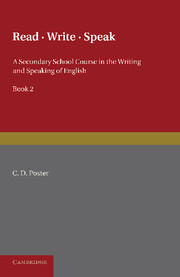Book contents
- Frontmatter
- Acknowledgements
- The Storyteller
- A Journey by Road
- Open Your Eyes
- ‘Telegram for You’
- Adventures with Animals
- Dead Man's Chest
- Wanted by the Police
- The Professor
- Take a Look at Yourself
- Among the Giants
- Disaster!
- Those Were The Days!
- Looking about you
- Moving Day
- News… and Views?
- Advertisements
Adventures with Animals
Published online by Cambridge University Press: 05 June 2016
- Frontmatter
- Acknowledgements
- The Storyteller
- A Journey by Road
- Open Your Eyes
- ‘Telegram for You’
- Adventures with Animals
- Dead Man's Chest
- Wanted by the Police
- The Professor
- Take a Look at Yourself
- Among the Giants
- Disaster!
- Those Were The Days!
- Looking about you
- Moving Day
- News… and Views?
- Advertisements
Summary
One of the best of a number of good writers on animals is Gerald Durrell. In The Drunken Forest he relates his and his wife's adventures in Paraguay in search of rare South American animals.
Next to the parakeets in the collection—who were shrill little friends—probably the noisiest and most cheeky of our birds were the two pileated jays. These birds are similar to the English jay in shape, though smaller and of a slighter build. Here, however, the resemblance ends, for pileated jays have long, magpie-like tails of black and white, dark velvet backs, and pale primrose-yellow shirt-fronts. The colouring on the head is extraordinary. To begin with, the feathers on the forehead were black, short and plushy, and stuck up straight, so the bird looked as though it had just had a crew cut. Behind this, on the nape, the feathers were smooth, and formed a sort of bluish-white marking which resembled a bald patch. Above each bright and roguish bronze eye was a thick ‘eyebrow’ of feathers of the brightest delphinium blue. The effect of this peculiar decoration was to give the birds a permanent appearance of surprise.
The jays were inveterate hoarders. Their motto was obviously ‘waste not, want not’. Any other bird given more minced meat than it could eat would have wastefully scattered it about the cage, but not so the jays; all those bits which they could not manage were carefully collected and stored in, of all places, their water-pot. For some reason they had decided the water-pot was the best place in which to keep their supply of food, and nothing we could do would make them alter their opinion. I tried giving them two water-pots, so that they could store their meat on one and drink out of the other. The jays were delighted with the idea and promptly divided up their meat and stored it in both water-pots. They would also store peanuts, of which they were inordinately fond.
Information
- Type
- Chapter
- Information
- Read Write Speak , pp. 38 - 51Publisher: Cambridge University PressPrint publication year: 2013
